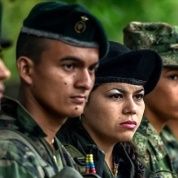Fifty-two years ago the Revolutionary Armed Forces of Colombia and the People’s Liberation Army were born in a world filled with constant threats to social movements committed to defending equality and standing up to foreign intervention.

The FARC-EP now has 13,892 members, of which 6,382 are combatants, and 7,510 are part of the support network.
1. Rough Beginnings: Hunted down
The FARC-EP was launched in 1964 by campesinos after hundreds of thousands were killed during one of the most violent periods of Colombian history known as "La Violencia."

In the 1960s throughout Latin America and the Caribbean, the United States government tried to destroy leftist movements and forces.
Any popular expression towards reforming the economic, social and political system was seen as a communist threat and had to be eliminated.
Colombia, on the other hand, was going through one of the hardest moments of its history, as land ownership favored the rich with subsidies for big landowners at the expense of the poor. Thousand of peasants were evicted from their land.
2. Politics: Power to the People

A Marxist-Leninist organization, the FARC-EP’s main objective has been to seize the political power in the country through rebellion and armed struggle.
They are against capitalism, imperialism, neoliberalism, war, environmental destruction, patriarchy and all forms of discrimination. They believe in Latin American and Caribbean integration, and self-determination for all nations.
3. Foreign Forces

The United States and Colombia consider it a terrorist organization, but some Latin American countries don't, including Ecuador, Brazil and Venezuela. Former Venezuelan president Hugo Chavez had asked Colombian authorities to recognize it as a military force, in order to begin the conflict resolution.
The United States has heavily criticized the group for its violent tactics, but hasn’t criticized the constant presence of paramilitary forces in Colombia and their atrocities. in the late 1990s the U.S. and the Colombian government launched Plan Colombia, a U.S.-financed plan to eliminate left-wing insurgent groups in Colombia.
4. Women’s Strength

Roughly 40 percent of the members of the FARC-EP are women. They are strong fighters, and have continued service within the FARC-EP even after being wounded in combat.
Some women have become commanders based on their capacities and merits. FARC-EP leaders have continuously said that women enter their forces under the same conditions as men.
They are also a critical asset in the peace process with the Colombian government, and lead the official negotiations in topics ranging from agriculture to political integration to participation of women and other oppressed sectors of society.
5. Peace Process

In 2011, the FARC-EP and the Colombian government agreed to begin talks in Havana, Cuba to reach a peace agreement that includes a cease-fire and disarmament.
The FARC-EP and human rights groups in Colombia have repeatedly said that peace cannot be achieved if the government does not acknowledge the existence of paramilitaries and take real steps to disarm them.
The final peace accord signed on Sept. 26 will now be put to the Colombian people in a plebiscite Sunday, Oct. 2. They cover agreements on agrarian reform, political participation, illicit drugs, the rights of victims and transitional justice and implementation.